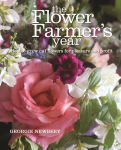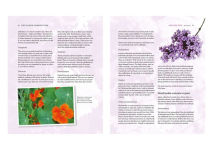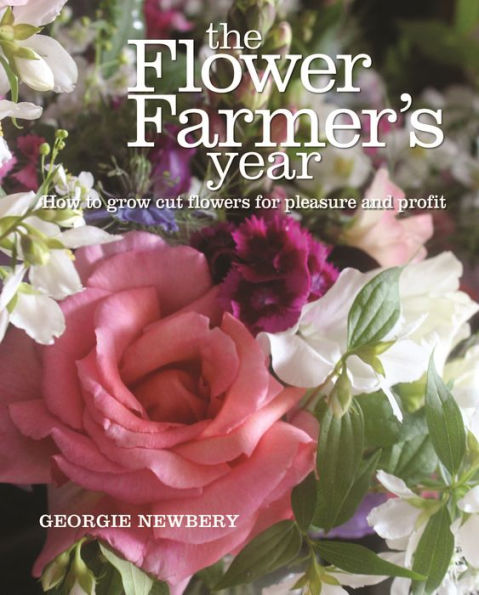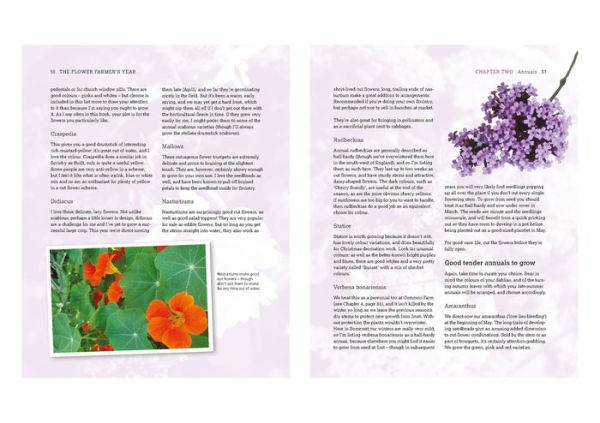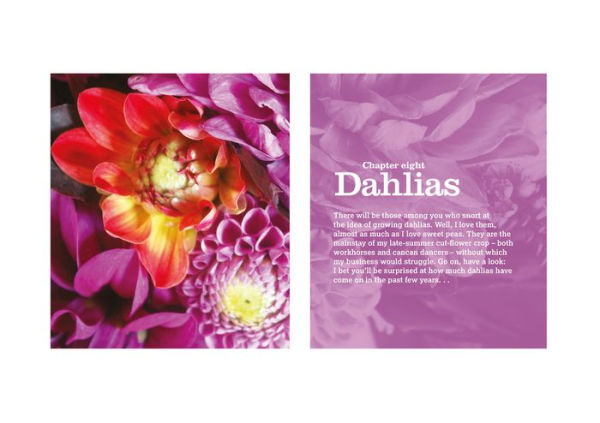Combining boundless passion with down-to-earth guidance and practical advice, Georgie Newbery draws on her own experiences as an artisan flower farmer and florist as she takes you through:
• how to start a cut-flower patch
• what to grow
• cutting, conditioning and presenting cut flowers
• creating a hedgerow Christmas
• starting a cut-flower business
• where to sell
• marketing and social media
• a flower farmer’s year planner.
Whether you want to grow for your own pleasure or start your own business, The Flower Farmer’s Year is the perfect guide.
Combining boundless passion with down-to-earth guidance and practical advice, Georgie Newbery draws on her own experiences as an artisan flower farmer and florist as she takes you through:
• how to start a cut-flower patch
• what to grow
• cutting, conditioning and presenting cut flowers
• creating a hedgerow Christmas
• starting a cut-flower business
• where to sell
• marketing and social media
• a flower farmer’s year planner.
Whether you want to grow for your own pleasure or start your own business, The Flower Farmer’s Year is the perfect guide.

The Flower Farmer's Year: How to grow cut flowers for pleasure and profit
256
The Flower Farmer's Year: How to grow cut flowers for pleasure and profit
256Hardcover
-
SHIP THIS ITEMIn stock. Ships in 6-10 days.PICK UP IN STORE
Your local store may have stock of this item.
Available within 2 business hours
Related collections and offers
Overview
Combining boundless passion with down-to-earth guidance and practical advice, Georgie Newbery draws on her own experiences as an artisan flower farmer and florist as she takes you through:
• how to start a cut-flower patch
• what to grow
• cutting, conditioning and presenting cut flowers
• creating a hedgerow Christmas
• starting a cut-flower business
• where to sell
• marketing and social media
• a flower farmer’s year planner.
Whether you want to grow for your own pleasure or start your own business, The Flower Farmer’s Year is the perfect guide.

Product Details
| ISBN-13: | 9780857842336 |
|---|---|
| Publisher: | Bloomsbury USA |
| Publication date: | 10/23/2014 |
| Pages: | 256 |
| Product dimensions: | 8.20(w) x 10.10(h) x 0.80(d) |
About the Author
Image (c) Heather Edwards
Read an Excerpt
The Flower Farmer's Year
How to Grow Cut Flowers For Pleasure and Profit
By Georgie Newbery
UIT Cambridge Ltd
Copyright © 2014 UIT Cambridge Ltd.All rights reserved.
ISBN: 978-0-85784-233-6
CHAPTER 1
Getting started
The blank canvas – the freshly fenced-off acre of a field – may be an exciting start to building your dream, but can be rather daunting in its emptiness. The trick is to chop your space into carefully planned, manageable chunks, and all of a sudden you'll have a strategy. Plant your ideas one small seed at a time, and watch them grow and bloom.
You need surprisingly little space to create a really productive cut-flower patch. At a lesson I taught in Northamptonshire recently, we assessed an ordinary-sized domestic garden space and identified a patch of the vegetable garden that would happily turn itself over to flower production.
In a bed of about 3m x 3m (10' x 10'), we saw room for perhaps 15 sweet pea plants, five ammi, five cosmos, five dahlias, five sunflowers, a row of cornflowers, a row of pot marigolds and a row of hare's ear. There were already roses in a herbaceous border edging the vegetable patch, and the herbs growing at the other end of the garden would make lovely scented foliage for the grower's posies. Among the group I was teaching were two garden designers, a florist, a baker, a writer, a lady with an allotment who wanted cut flowers for her house, and another who wanted to sell mixed bunches from her front gate. None of these people would call themselves 'eco-warriors' – they were simply sensible people who had looked at the inter national cut-flower trade and didn't like what they saw. They realized that if one is a gardener of any kind, one can grow cut flowers – which will not only satisfy the aesthetic desire for cut flowers in the house, but also feed the bees.
So, you have your dream – or even your patch, your meadow, your corner of a rented field. It's time to lay out your plot. Go and stand in it, sniff the wind, test the earth, and think hard before you apply the sharp edge of spade to soil. The better planned your plot is, the harder it will work for you.
Plot design and practicalities
Whether you're planning a single bed for small-scale growing or several acres for commercial production, the same design rules apply. Think carefully about how you will lay out your patch, and you will save yourself time, energy and (most of all) irritation later on. A carefully planned garden will reward you time and again for the work you put into getting the mechanics of it right.
How much space?
If you're growing to sell at your gate, at farmers' markets or to local florists, beds of 3m x 1m (10' x 3') will never be too long to walk around or too wide to reach across without treading on. It's a good idea to begin with one bed cut into three (or three whole beds, and so on), since if your beds are divisible by three, you're set up for a plant rotation system (see page 21). If you then lay out another bed to the windward side of your first bed, to help with wind protection (see page 19), you are ready to plant a substantial crop in three annual beds and one perennial – all possible in less space than the size of an average allotment.
Cutting your space up into small sections also makes the job less daunting for any grower, as you can achieve great things by dealing with one small section at a time. A great ploughed plain before you is daunting, whereas a series of small areas that can be dealt with one at a time is a list of surmountable challenges.
What to grow
There's no need to try to include a wide variety of flowers in your patch. You can be a professional cut-flower farmer and grow as few as ten different varieties – the skill is in being clever about which ones you choose. The advice and recommendations in this book should help with making your choice, but remember that the most important thing is to grow flowers that you love. A patch of something you grow because you think you ought to, but which you don't love, will be ignored and will cost you money in wasted space. I never grow cleome because I hate the smell and the spines. I could think that I ought to include it, because it's a classic annual to grow for cut-flower production, but I've learned – to my cost in space and time – that I won't pay it any attention other than to be annoyed by it.
Last year in our garden we planted up two 3m x 1m (10' x 3') beds as follows:
* Bed 1: Lots of Ammi majus (we use a great deal of ammi in our summer flowers) and three rows of cerinthe (a generous cut flower, which we use largely for its glaucous blue-green leaves, but the stems can get straggly so we plant successionally through the summer and put the plants out in small chunks as space fillers).
* Bed 2: A mix of pale blue cornflowers, larkspur, orlaya and annual scabious.
These beds started flowering at the end of May and we cut from them until September – you can expect to get a maximum of two months' useful production out of an annual plant.
Both the beds have low hedges of young box plants at one end, and one of them has a small hedge of Spiraea japonica 'Candlelight' at the other end.
So from just this small planting area we had cut flowers and greenery to take us all through the season. I could have planted fewer ammi and put a stand of sweet peas at one end of that bed instead, and then this really would have been a great cutting mix for posies, for a farmers' market, to supply buckets of flowers for do-it-yourself weddings, and so on ...
Windbreaks
Cut flowers are, of course, valued for their looks – which are easily ruined by the weather. And so protection from the weather is what they need most. Before laying out your cut-flower patch, first consider the wind: where it comes from most of the time, and how you can stop it flattening your cosmos, dahlias, sweet peas and so on.
Don't plan to build an expensive solid wall as a windbreak. The wind will rush at it, hit it, be forced up over it and then crash down, flattening whatever's on the other side. People with walled gardens often complain about odd areas where eddies of air become whirlwinds in bad weather, causing all sorts of damage to their precious plants. It's best to construct a windbreak that allows some air to pass through.
So think of using hedging, or trellis fencing, or even, in the short term (while your hedge grows), some green mesh netting for windbreaks. Or – since few people have more gardening space than they know what to do with – it can be a good idea to create your windbreak with plants that you can later use as foliage to accompany your flowers.
One way of doing this is to dedicate some beds down the windward side of your plot to perennials. This creates extra wind protection for your annuals and biennials, helping them establish without suffering 'wind rock' (damage to roots caused by movement of the stem in the wind). If you don't have space for this, perhaps establish some bushy perennials or shrubs at the windward end of your beds, for both greenery and wind protection.
A patch of something you grow because you think you ought to, but which you don't love, will be ignored and will cost you money in wasted space. I never grow cleome because I hate the smell and the spines. I could think that I ought to include it, because it's a classic annual to grow for cut-flower production, but I've learned – to my cost in space and time – that I won't pay it any attention other than to be annoyed by it.
Rabbits and deer
If there are rabbits or deer in your area, you'll need to fence them out. Deer love rose tips and new growth on shrubs; rabbits will mow your crops as if they were a lawn, and ring your trees and shrubs effectively enough to kill them. Each sweet pea flower is potentially worth as much as 65p to you, so don't let the rabbits have them! Edge your plot with chicken wire, buried underground horizontally for 30cm (12") under about 2cm (approx. 1") of turf, and you should be able to keep rabbits out (see the illustration opposite for finer design details). Don't forget to line your gates with chicken wire too, or the rabbits will squeeze under or through the bars. When it comes to deer, fencing will need to be 1.2-1.5m (4-5') high to deter them.
While deer fencing is costly, shrubs and roses are an expensive investment that you would probably rather not lose to nibbling night-time visitors.
I have heard that planting autumn-flowering crocus around your cut-flower garden will repel deer and rabbits, and it does sound like an attractive solution. I have a friend who stands a length of fluorescent strip lighting in the corner of her cut-flower field, attached to a solar-powered battery to flicker and put off marauding varmints – again, I've never tried this, and if you have neighbours overlooking your patch, it might be irritating to them. Alternatively, dousing around your plants with chilli and garlic dip (see Chapter 5, page 86) will discourage rabbits and deer. Personally, I prefer just plain fencing: it is an expensive investment, but time spent making chilli and garlic dip for protecting plants individually might drive you madder in the end!
Planting rotation
As with all crops, it's a good idea to design your plot with a rotation in mind, for the same reason as you would cabbages, peas and potatoes around vegetable beds: to avoid the build-up of pests and diseases. If you arrange your beds in threes, with a fourth bed on the windward side for perennials, then that's a pattern you can work with as you expand your patch, or can scale up if you're creating a bigger patch in the first place.
The flowers you will be growing for cutting won't fall neatly into 'family groups' in the same way that veg do, so the way you arrange your rotation won't be as categorized as it might be for veg: the idea is just to avoid growing the same species on the same piece of land from one year to the next. You can choose the plants you're likely to grow most of and base your rotation on them: for example, a rotation of sweet peas, dahlias, and a bed of other annuals is a good mix; or a bed of biennials, a bed of sweet peas, and a bed of some other annuals; and you could add a perennial bed of roses under-planted with herbs and alchemilla, for example.
Since sweet peas are legumes, as are any pea or bean, they will fix nitrogen in your soil, so if you're going to grow them, use them as number one in your rotation plan. Your other annuals, your dahlias or your biennials can then follow your sweet peas in rotation, year-on-year.
Raised beds
You should consider 'flower farming' your patch in raised beds for a great many reasons, not least because in your first season or two the scale of your task may seem daunting, and, as noted earlier, a daunting job chopped into manageable sections becomes possible rather than overwhelming. You can weed a small raised bed in 20 minutes. You can plant a small raised bed in 20 minutes. You can cut all the flowers available from a small raised bed in 20 minutes. If we'd grown flowers in larger areas when we started, I know I would not have been able to see the individual jobs to do because of the overwhelming scale of the area in which they needed to be done. There are other advantages of raised beds too:
* If you lay out three, six or twelve beds at a time, you've always got a three-way rotation, which makes it easy to manage your yearly planting plan.
* You can optimize the size of your beds to avoid ever needing to tread on the soil.
* If you're gardening on clay, you can dramatically increase drainage and improve the soil condition by 'making' the soil yourself – with the addition of well-rotted horse manure and garden compost – within the confines of a raised bed.
* Ditto for chalk or gravelly soil: you can increase fertility and water retention by feeding them with a great deal of well-rotted horse manure and garden compost.
* The beds offer some protection against wind rock for newly planted-out plants, and make it easier for you to give some protection to seedlings, with fleece or shade mesh.
Staking
There are three basic options for staking plants, whether annual or perennial.
Pea netting
Provide horizontal support with pea netting laid flat at a height of about 1m (3'), tied to stakes at regular intervals along the bed (as pictured overleaf). This is an extremely efficient way to support your crops and is not difficult to put up. You might think that this kind of netting might get in the way, but you can hoe around the plants easily enough under it, and when cutting your flowers, the spacing in the netting is wide enough for you to easily reach down through it to get the maximum stem length. It is more annoying to lose a whole crop to a big storm than to have to work around a little support netting through the season.
String or twine
The greener version of pea netting is to stake the edges of your beds at regular intervals and run a zigzag of garden twine horizontally along the bed. It won't be as strong as the pea netting, but it works well on a small cut- flower patch, and is an acceptable solution if you are very conscious of the ecological 'footprint' of your gardening.
Stake plants individually
In my view this is the least effective approach: it is a fiddly waste of time. You can make teepees of bamboo or hazel clippings for roses to grow through, and a similar arrangement will work well if you have, say, four or five dahlia plants. But for a whole bed of dahlias, staking with one of the netting arrangements described above will give your plants much greater support and save you a great deal of time. If they have grown through netting or a zigzag of string they'll survive a storm much better than if they can break their individual supports, or pull them up. A serious August storm will flatten a whole dahlia bed if it's not properly supported, and this will hurt much more than the work that goes in to providing them with a proper structure to grow through earlier in the season.
Soil, compost and feeding
Without soil in good heart (and a pretty neutral pH of about 7), your success as a grower will be limited. Cut-flower growing is a greedy business – especially in the case of annuals, which need a lot of nutritional support in their race to germinate, grow, flower and go to seed in one season. Remember that however you choose to make your beds, you are creating soil structure. You will inevitably add manure, compost, leaf mould, etc. – and that's before you get to compost tea and seaweed solution, lime, etc. ... And what will you mulch with? 'Strulch' (straw-based compost – good for keeping plants warm in the winter), municipal green-waste compost, spent mushroom compost ...?
So, you will be creating soil. As the seasons turn, and perhaps twice or even three times a year, your beds will be cleared, replanted and expected to perform again. Every time you do this you disturb the soil structure, and create a new structure for your next crop to grow in.
I recommend Charles Dowding's books for advice on no-dig gardening and building no-dig raised beds. You could also look at the Ten Minute Gardener on YouTube for a demonstration of building no-dig beds. That said, we don't do 'no dig' here at Common Farm. This is partly because we garden in a meadow where creeping buttercup, pendulous sedge and couch grass invade our beds from every side through out every season, and Fabrizio and I are both obsessive about getting every last bit of root out. But it is also, mostly, because our long-ingrained habits involve a border fork (me) and a rotavator (him). At the end of the day, you are making a cutting patch which must first and foremost suit you. Going too hard against your own gardening habits may actually slow you down. So, we rotavate our beds hard when we create them (we have to mix in a great deal of drainage material and compost to break up our solid clay soil), but once the beds are made we don't dig them hard again at all. We simply mulch generously once a year, and feed the soil and plants often.
In a small patch, so not too great an area to manage, experimenting with no- dig is a good idea. Perhaps, if you start with three rotating beds, you might have one no-dig bed, one half-dig (which I suppose is what we do – lots of layering, but never double-digging) and one double-dig (as your grandfather might have taught you).
Soil pH
It is always worth testing your soil pH: testing kits are cheap to buy from any garden centre. Test the soil in several different areas of your patch – a limey soil in one corner does not promise limey soil elsewhere. And don't assume that once you've tested your soil and done something to balance its pH, if it's very acid or alkaline, that the pH will stay the same from one season to another. The plants you grow, what you feed them with, and the compost and manure you add will all have an effect on your soil balance. So check the soil pH once a year or so.
Be aware that spent mushroom compost and municipal green-waste compost can be alkaline. Even so, at Common Farm we do use municipal green-waste compost, because it's easy to source locally and because it's peat-free. It is useful for building up beds and as a mulch – yes, it's fibrous and not necessarily very nutrient-rich, but nutrients are added in garden compost, manure and liquid feeds.
(Continues...)
Excerpted from The Flower Farmer's Year by Georgie Newbery. Copyright © 2014 UIT Cambridge Ltd.. Excerpted by permission of UIT Cambridge Ltd.
All rights reserved. No part of this excerpt may be reproduced or reprinted without permission in writing from the publisher.
Excerpts are provided by Dial-A-Book Inc. solely for the personal use of visitors to this web site.
Table of Contents
Foreword by James Alexander-SinclairIntroduction: Why grow cut flowers?
1. Getting started
2. Annuals
3. Biennials
4. Perennials
5. Bulbs & corms
6. Shrubs
7. Roses
8. Dahlias
9. Sweet peas
10. Herbs
11. Wildflowers
12. Cutting, conditioning & presenting cut flowers
13. Hedgerow Christmas
14. Starting a cut-flower business
15. Where to sell
16 . Marketing & social media
Afterword
Appendix 1: The flower farmer’s year planner
Appendix 2: Plant names
Resources
Index
